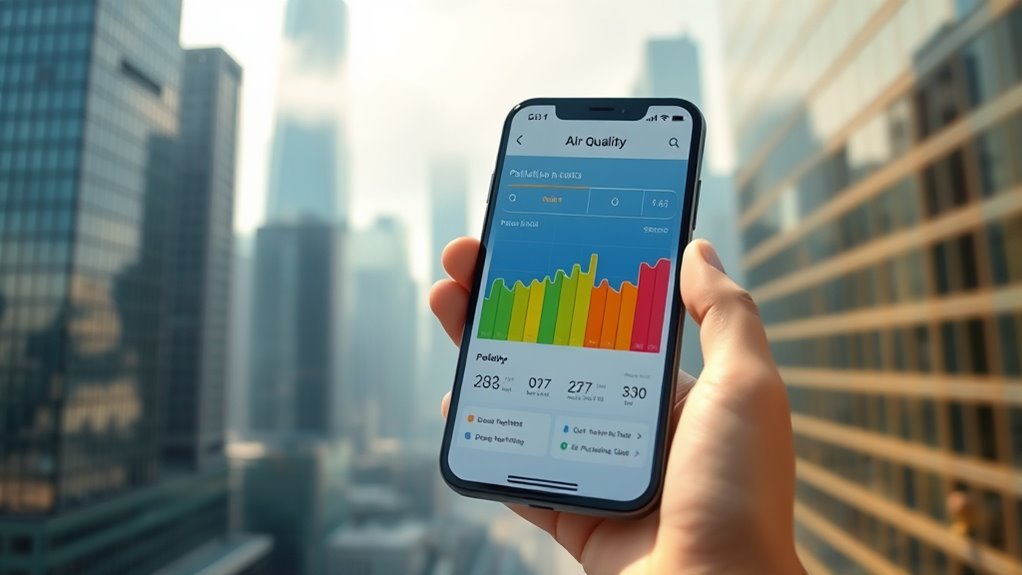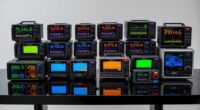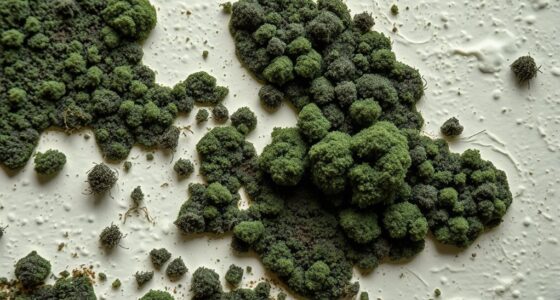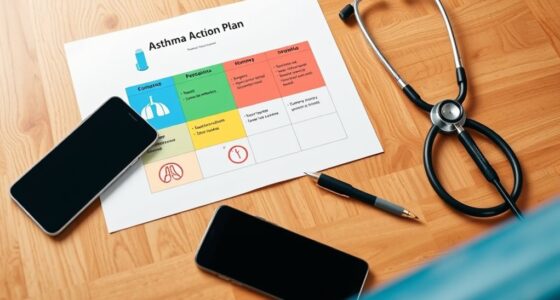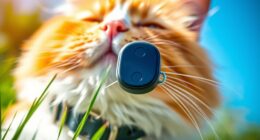Air quality apps can give you useful insights, but their accuracy varies. They gather data from sensors, government stations, satellites, and user reports, so quality depends on source reliability. Sensors differ in precision, and environmental factors like weather can influence readings. While they offer quick estimates, they might not always reflect actual conditions precisely. To understand their limitations better and get more reliable info, keep exploring how these apps work and improve.
Key Takeaways
- Data accuracy varies based on sensor quality, calibration, and environmental factors, with government stations generally more reliable than mobile sensors.
- Sensors like electrochemical, optical, and metal oxide types have differing precision; proper calibration and correction improve their reliability.
- External influences such as temperature, humidity, and interference can cause discrepancies in app readings, impacting accuracy.
- Indoor sensors or crowd-sourced data may not accurately reflect outdoor air quality, leading to potential misinterpretations.
- Advances in sensor technology, AI integration, and sensor networks are enhancing the precision and timeliness of air quality app data.
How Do Air Quality Apps Gather Data?
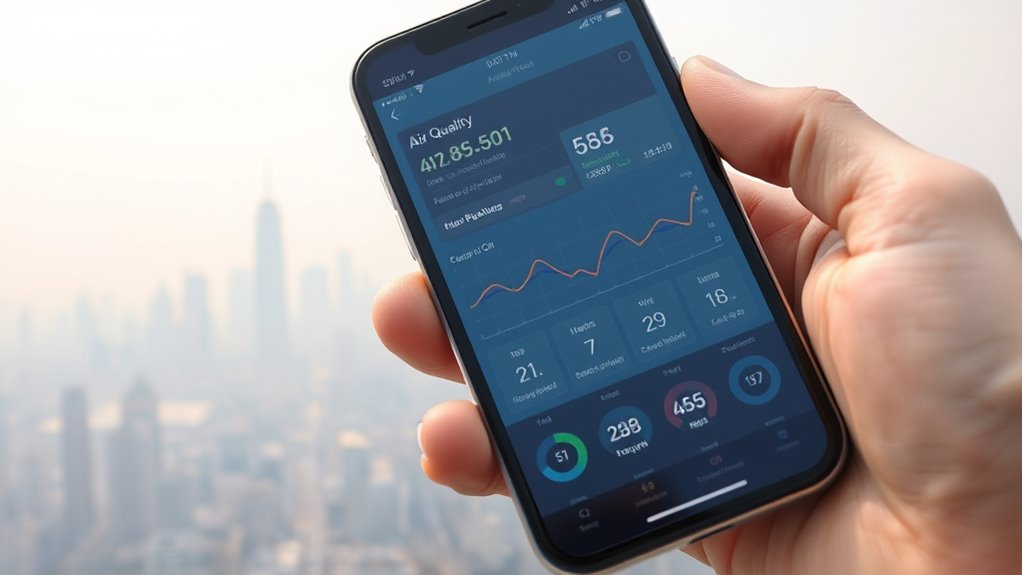
Air quality apps gather data primarily through a combination of real-time sensors and government monitoring stations. When you open an app, it pulls information from sensors placed in various locations, which measure pollutants like PM2.5, ozone, and nitrogen dioxide. These sensors provide immediate data on local air quality conditions. Additionally, the apps access data from government monitoring stations that are strategically located across regions. These stations collect thorough, standardized measurements and regularly upload their findings. The app then processes this data, often combining multiple sources to give you a current air quality index. This approach helps guarantee you get timely, localized information. By integrating sensor data and official reports, air quality apps aim to provide accurate, real-time insights into the air you breathe.
The Technology Behind Air Quality Monitoring
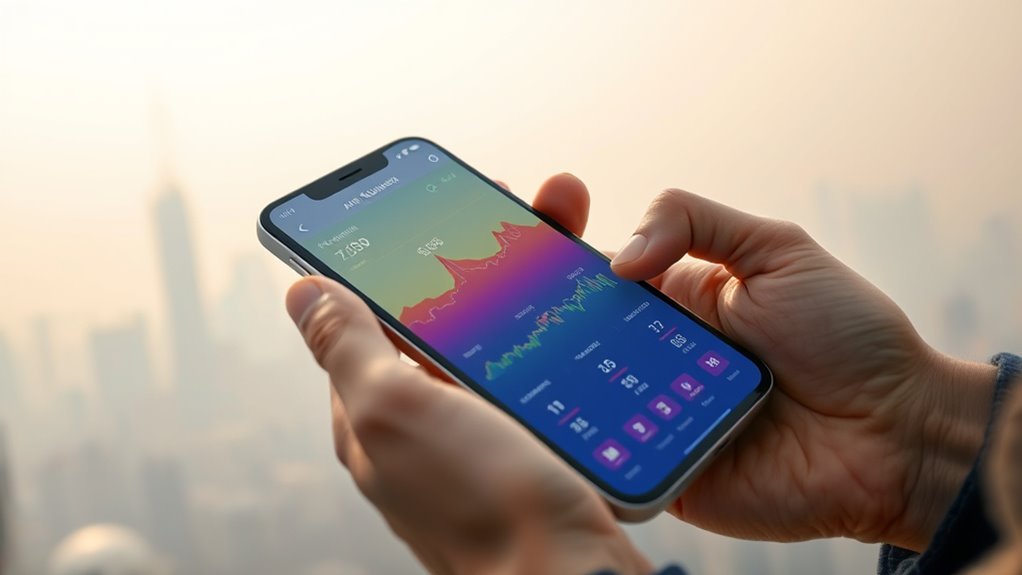
You’ll find that sensors like electrochemical, optical, and metal oxide play a key role in detecting air pollutants. These devices collect raw data, which then gets processed using algorithms to guarantee accuracy. Understanding these technologies helps you see how air quality apps provide reliable information you can trust. Additionally, advancements in GMC tuning have led to more precise calibration methods, further enhancing sensor reliability and data accuracy in air quality monitoring.
Sensor Technologies Explained
Sensor technologies form the backbone of air quality monitoring systems, enabling precise detection of pollutants in real time. Different sensors target specific pollutants, such as particulate matter, nitrogen dioxide, ozone, and carbon monoxide. Optical sensors use light scattering to measure particles, while electrochemical sensors detect gases through chemical reactions that produce electrical signals. Metal oxide sensors change resistance when exposed to certain gases, providing rapid readings. Some sensors incorporate nanotechnology for enhanced sensitivity and miniaturization. These sensors often work together within a device, creating a detailed picture of air quality. Advances in sensor design have made monitors smaller, more affordable, and easier to deploy in various environments, from urban areas to personal devices. Understanding these technologies helps you gauge the reliability of air quality data you rely on daily.
Data Processing Methods
Once sensors collect raw data on pollutants, sophisticated data processing methods transform these signals into meaningful air quality insights. These methods filter noise, calibrate measurements, and correct for environmental factors like temperature and humidity. They also aggregate data from multiple sensors to improve accuracy and create thorough air quality indices. Machine learning algorithms analyze patterns, identify anomalies, and predict pollution trends. Data normalization ensures consistency across different devices and locations. Real-time processing allows for instant updates, giving you current air quality levels. Additionally, statistical models help validate sensor readings, reducing errors. The integration of AI-driven analysis enhances the ability to interpret complex data sets and refine air quality assessments. This combination of techniques ensures that the information you receive from air quality apps is as reliable and precise as possible.
Differences Between Sensor Types and Their Accuracy
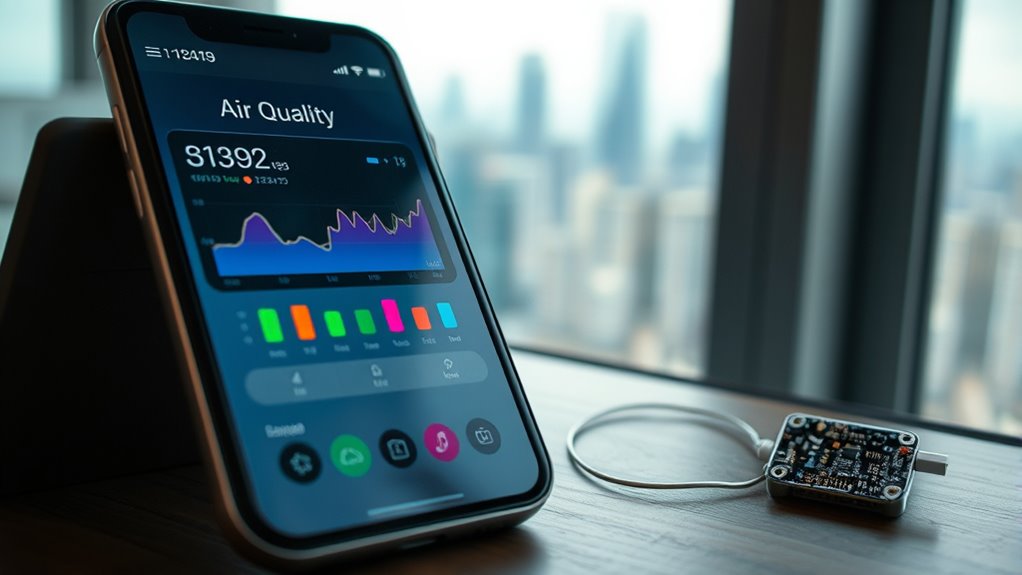
Different types of air quality sensors vary markedly in their design and capabilities, which directly impacts their accuracy. Electrochemical sensors detect specific gases like ozone or nitrogen dioxide, offering good precision but can degrade over time. Metal oxide sensors are more affordable and versatile but tend to be less accurate and more affected by environmental factors like humidity and temperature. Optical sensors use light scattering to measure particulate matter, providing reliable data for PM2.5 and PM10, but their performance can be influenced by particle composition. Some portable sensors combine multiple detection methods to improve accuracy, yet they still may not match the reliability of professional-grade equipment. Understanding these differences helps you evaluate which sensor type best suits your needs, balancing cost, convenience, and data precision. Additionally, sensor calibration plays a vital role in ensuring ongoing accuracy and reliability of air quality measurements.
Data Sources and Their Impact on Reliability
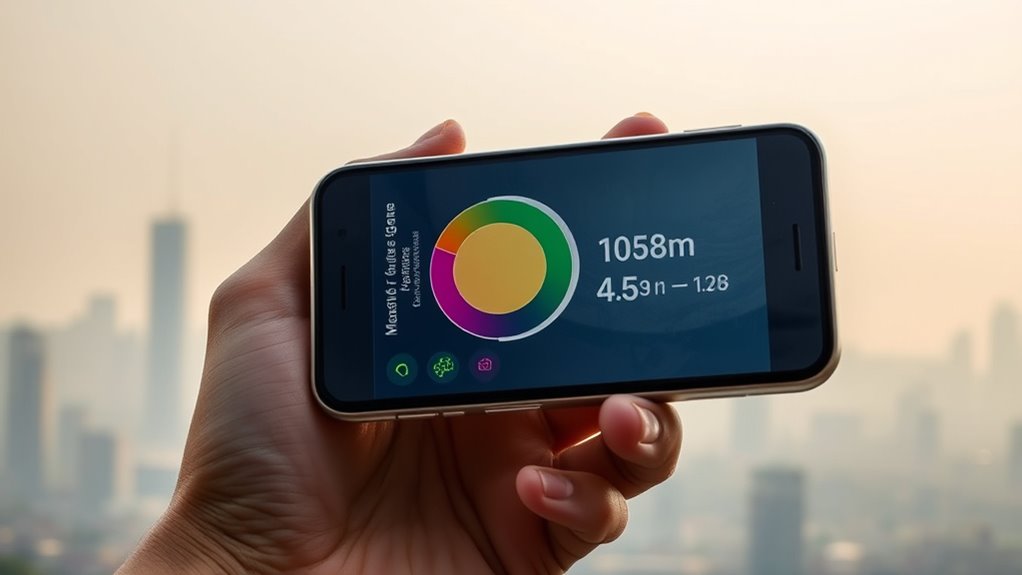
The reliability of air quality data from apps largely depends on the sources they use. These sources range from government monitoring stations to user-generated sensors. Government stations provide highly accurate, standardized data but are few and often lack real-time updates for specific locations. Mobile sensors offer more localized readings but can vary in accuracy due to calibration issues. Some apps incorporate data from satellite imagery, giving broad regional insights but less detail for individual areas. Data aggregation from multiple sources can improve coverage but may introduce inconsistencies. Ultimately, user reports contribute real-time, crowd-sourced info but can be subjective and less reliable. Understanding these sources helps you gauge the trustworthiness of the data you’re viewing. Additionally, the technology behind Home Theatre Projectors has advanced to include high dynamic range (HDR) and enhanced color accuracy, which can influence the quality and reliability of visual data in certain applications.
Limitations and Challenges of Mobile Air Quality Monitoring

You might notice that sensor accuracy varies between different air quality apps, which can affect the reliability of the data you see. Interpreting this information can also be tricky, especially when sensors produce inconsistent readings. These limitations highlight the ongoing challenges in ensuring mobile air quality monitoring is both precise and easy to understand. Additionally, the effectiveness of many air purifiers depends heavily on regular filter replacement, emphasizing the importance of proper maintenance for accurate air quality improvement.
Sensor Accuracy Variability
While mobile air quality sensors offer convenient monitoring, their accuracy can vary markedly due to technical limitations and environmental factors. You might notice inconsistent readings depending on conditions. Several factors influence this variability:
- Sensor calibration drift over time
- Temperature fluctuations affecting sensor response
- Humidity levels impacting sensor sensitivity
- Interference from other airborne particles or gases
- Differences in sensor quality across brands and models
- Sensor reliability can be compromised by external influences, reducing the consistency of measurements.
These issues can cause sensors to overestimate or underestimate pollutant levels. As a result, readings may not always reflect real-world air quality accurately. You should be cautious when interpreting data, especially for making health or safety decisions. Recognizing these limitations helps you better understand the reliability of mobile air quality monitoring.
Data Interpretation Challenges
Interpreting data from mobile air quality sensors can be challenging because their readings often don’t perfectly reflect actual conditions. Variations in sensor calibration, environmental factors, and device placement can cause discrepancies. For example, a sensor might show high pollution levels indoors but lower outdoors, even if the air quality is worse inside. Data can also be affected by temperature, humidity, and interference from other pollutants. Without proper context or understanding of these factors, you might misjudge the air quality. Many apps lack the ability to adjust or correct for such influences, leading to potential misinterpretations. Additionally, sensor accuracy can vary depending on the device quality and maintenance, further complicating interpretation. As a user, you need to be cautious and consider additional information, like local air quality reports, to accurately assess your environment.
Comparing App Data With Official Monitoring Stations
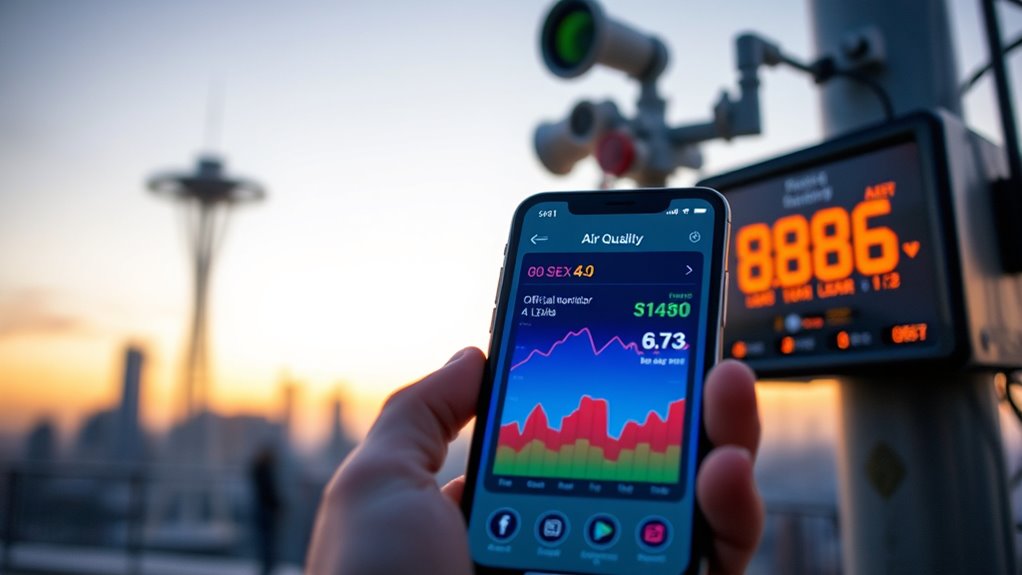
Comparing app data with official monitoring stations is essential for evaluating the accuracy of air quality apps. You need to see how well app readings align with trusted, government-operated stations. When doing this comparison, consider factors like:
- Proximity to monitoring stations, as closer locations tend to match more closely
- Time of day, since air quality can fluctuate rapidly
- Data lag, where app updates might be delayed compared to official reports
- Measurement units, ensuring consistency between sources
- Variations in sensor quality and calibration
- Understanding angel number soulmate patterns can help interpret fluctuations in air quality data and recognize when environmental changes might influence sensor readings.
Factors That Affect the Precision of Readings
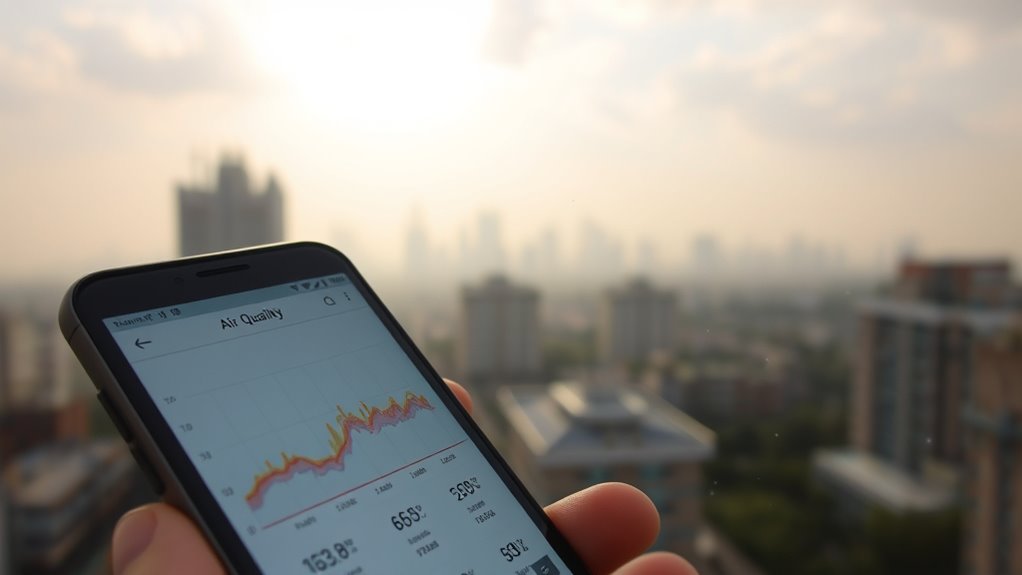
Several factors directly influence the precision of air quality readings from apps. Your device’s location accuracy plays a big role, as even small deviations can alter results. Sensor quality varies widely between apps; some use advanced technology, others rely on rough estimates. Environmental conditions like weather, humidity, and pollution sources can also impact readings. Keep in mind that data sources differ, affecting accuracy. Here’s a quick overview:
| Factor | Impact on Accuracy |
|---|---|
| Location precision | Determines proximity to pollution |
| Sensor quality | Affects measurement reliability |
| Environmental conditions | Can skew readings temporarily |
| Data source variability | Leads to inconsistent info |
| Update frequency | More frequent updates improve accuracy |
Additionally, calibration methods used in sensors can influence how closely readings reflect actual air quality. Understanding these factors helps you interpret app data more critically.
Tips for Interpreting Air Quality App Data Safely
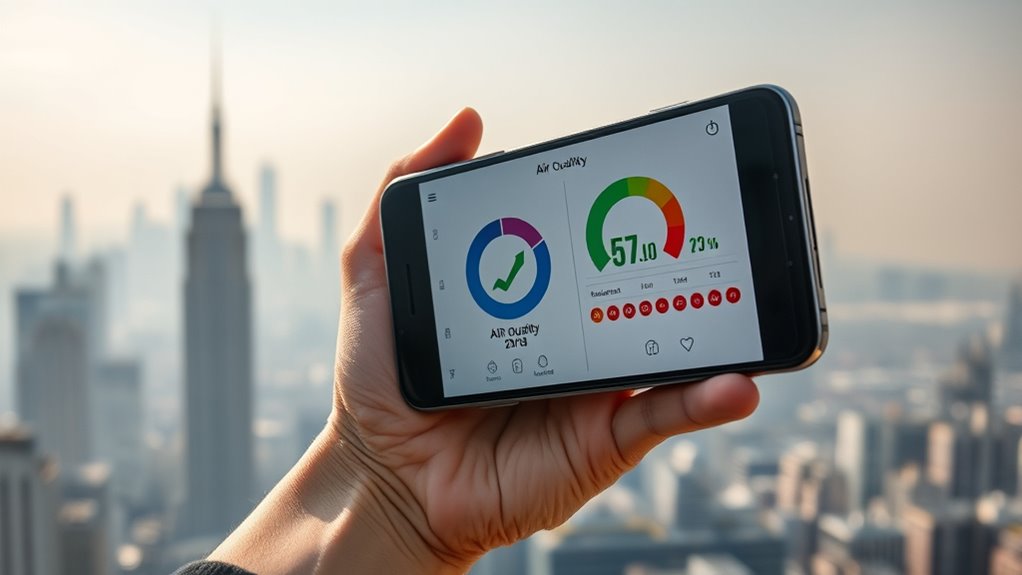
To interpret air quality app data safely, start by understanding that these readings are estimates influenced by various factors. Recognize that location, time of day, weather conditions, and device calibration can all affect accuracy. To avoid misjudging air quality, keep these tips in mind:
- Check the data against official air quality reports when possible
- Consider the time of day, as pollution levels fluctuate
- Be aware of your local environment—urban vs. rural areas matter
- Use multiple apps to compare readings for consistency
- Avoid making health decisions based solely on app data, especially during sensitive conditions
Additionally, being aware of AI Discoveries that involve environmental data manipulation can help you understand the potential for innovative solutions in air quality monitoring.
Future Developments in Air Quality Monitoring Technology
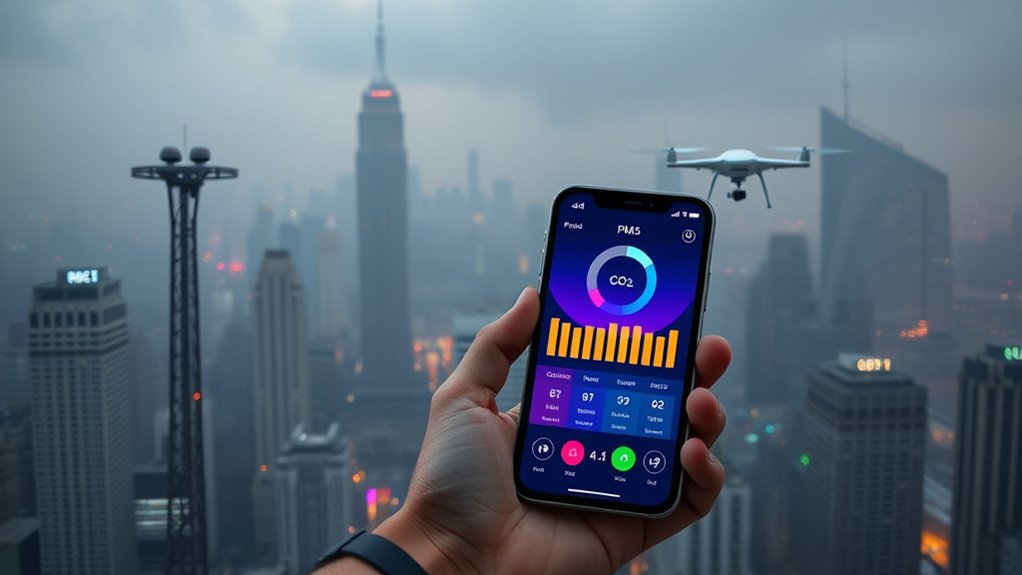
Advancements in air quality monitoring technology are set to revolutionize how you track and respond to pollution. New sensors are becoming more affordable, portable, and accurate, enabling real-time data collection at a local level. These innovations will integrate seamlessly with smartphones and wearables, providing instant updates and personalized alerts. Additionally, smart networks will connect multiple sensors, creating exhaustive pollution maps that inform public health decisions. Expect improvements like rapid data processing and AI-driven predictions, making pollution trends easier to understand and act upon. Here’s a quick look at upcoming developments:
| Technology | Impact |
|---|---|
| Miniature Sensors | More widespread, accessible monitoring |
| AI and Data Analytics | Better prediction and proactive alerts |
| Network Integration | Enhanced spatial coverage and detailed insights |
Frequently Asked Questions
Can Air Quality Apps Predict Future Pollution Levels Accurately?
You might wonder if air quality apps can predict future pollution levels accurately. While they use historical data, weather forecasts, and sensor info to make predictions, their accuracy isn’t always perfect. Many factors influence pollution, making precise forecasts challenging. However, these apps can give you useful trends and alerts, helping you plan outdoor activities and stay informed about potential risks, even if they can’t guarantee 100% accuracy.
How Do Weather Conditions Influence App Readings’ Accuracy?
Weather conditions significantly impact the accuracy of air quality readings. When it’s windy, pollution disperses, making readings seem better than they truly are. During rain, particles are washed out, skewing data. Temperature and humidity also affect sensors’ performance. You should keep in mind that rapidly changing weather can cause fluctuations in app readings, so it’s helpful to take into account local weather reports alongside app data for a clearer picture.
Are There Privacy Concerns With Data Collection in These Apps?
When you use air quality apps, privacy concerns can come up because they often collect your location data and personal information. This data helps improve app accuracy but might be shared with third parties or used for targeted advertising. You should always read the privacy policy, adjust your app settings, and be cautious about what information you share to protect your privacy while using these apps.
Do Air Quality Apps Work Effectively in Rural Versus Urban Areas?
Imagine you’re a digital pioneer steering the air around you. In urban areas, air quality apps tend to be more effective because they access dense sensor networks and real-time data. In rural regions, these apps may struggle due to fewer sensors, making data less accurate. So, while they help in cities, expect less precision in countryside settings. Always verify with local sources for the most reliable air quality info.
How Often Should I Calibrate or Update My Air Quality App?
You should regularly update your air quality app to guarantee the data stays current, ideally once a week or whenever you notice discrepancies. Calibration isn’t usually necessary for most apps, as they rely on external data sources. However, check for updates or calibration prompts from the app developer, especially if you experience unusual readings. Keeping your app updated helps you get the most accurate and reliable air quality information.
Conclusion
While air quality apps provide quick insights, don’t rely on them alone for health decisions. They offer a helpful snapshot, but limited sensor accuracy and data gaps mean they can’t replace official stations. Trust them as a guide, not a guarantee. With ongoing tech advances, they’ll get better, but always check local air quality reports for the most reliable info. Stay informed and prioritize your health with multiple sources.
